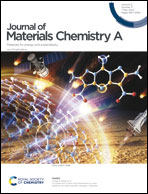Optimization of a NiMo catalytic electrode based on the distribution map of HER onset potential†
Abstract
Hydrogen energy is deemed as one of the competent alternatives to traditional energy sources. The catalytic electrode plays a crucial role in the hydrogen evolution reaction (HER), and it should have a low onset potential and a uniform distribution. This work utilized a total internal reflection imaging (TIRi) method to characterize the onset potential distribution of the catalytic electrode. When the potential scans towards negative in linear sweep voltammetry (LSV), H2 microbubbles are generated on the electrode surface at the onset of the HER, leading to a decrease in the effective refractive index (RI) and a change in the optical intensity. The distribution of the onset potential can be obtained by analyzing the relationship between the optical intensity and potential in each region. This work drafts the distribution maps of HER onset potential, screens the electrodeposition parameters that have a greater impact on the performance of the prepared NiMo catalytic electrodes, and optimizes these parameters to achieve the best electrode performance. The prepared electrode was tested for chronopotentiometry (CP) and showed good stability. The TIRi method can visualize the activity distribution on the electrode surface, which is significant for preparing catalytic electrodes and practical industrial hydrogen production.



 Please wait while we load your content...
Please wait while we load your content...